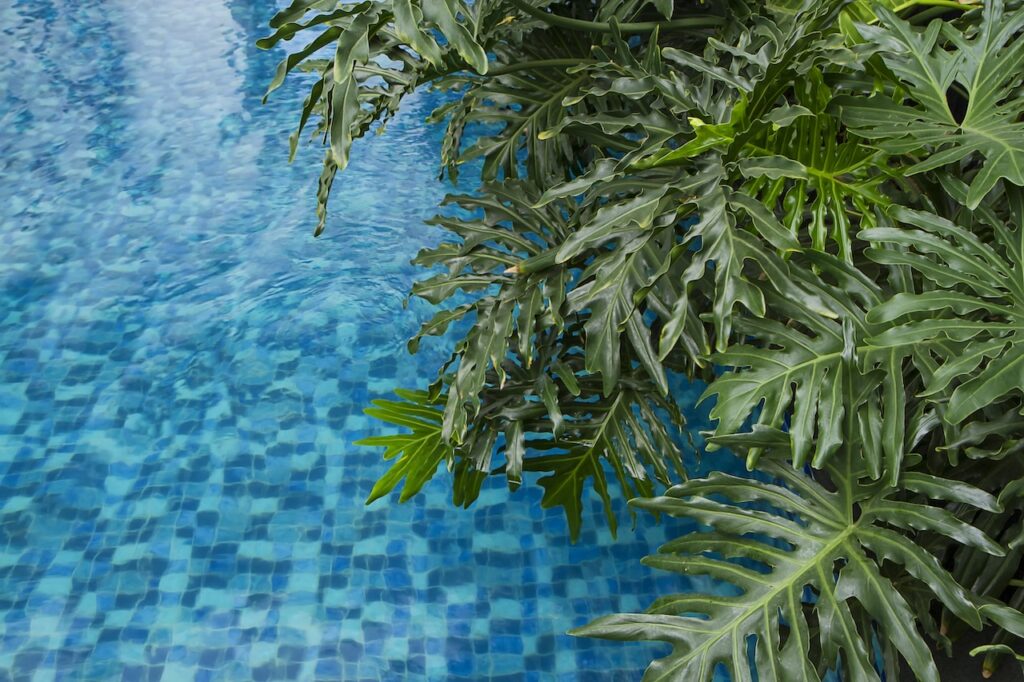Picture this: You’ve recently built the pool of your dreams, surrounded by beautiful green landscaping. But one day you notice that some of your plants are starting to wilt, and you find yourself looking at the nearby water with suspicion. Can pool water kill plants?
Most people know that pool water, especially when chlorinated, can pose risks to plants if not managed properly.
The answer is a bit more complicated than a simple yes or no. This guide breaks it down for you, answering whether pool water—often involving thousands of gallons—can be harmful to your greenery and how to protect your plants so that both your pool, lawn, and yard thrive in harmony.
Can Pool Water Kill Plants?
The truth is, it depends. Some plants are more resistant to chlorinated water from swimming pools than others, but in general, it’s not a good idea to water your plants using pool water or expose them to excessive splashing. Chlorinated water, whether treated with chlorine or salt, contains elements that can harm plants, lawns, vegetables, and the broader landscape over time. When pool water is drained, especially during summer, it’s important to check chemical levels before reuse to avoid harming your garden. Plants drink water from the dirt, and any chemicals present—including chlorine—can be absorbed by roots and other delicate tissues. Even if some plants appear fine after occasional exposure, long-term effects can occur, especially as small amounts of pool water accumulate in the soil.
The primary concern with pool water is the chemicals used to keep it clean and safe for swimming. It is crucial to monitor the chlorine level in pool water, as high concentrations can damage plants, lawns, and beneficial bacteria in the soil. Pool water should always be tested for chemical levels before using it to water plants or lawns. Before using pool water on a lawn, it is important to dilute or treat the water to minimize the risk of chemical and high salt concentration damage, as untreated pool water can harm grass and other plants. Diluting pool water with fresh water can help reduce the risk, but even then, sensitive plants and vegetables may not tolerate chlorine well. Here are some chemicals that can be problematic for plants if exposure is frequent or excessive:
- Chlorine: This can be harmful to plants if applied directly or through excessive splashing. High chlorine levels can damage plants, especially sensitive species and other delicate tissues. While the chlorine in pool water is typically diluted enough to minimize damage, there is a greater risk of damage whenever fresh chlorine is added to the pool. Some hardy plants may tolerate low levels of chlorine, but caution is advised.
- Algaecides: These chemicals control algae growth in your pool but can be toxic to plants and soil microbiomes, affecting beneficial bacteria and reducing oxygen availability in the dirt.
- pH Adjusters: Pool water with altered pH levels can disrupt the pH balance in the soil, making it harder for plants to absorb nutrients.
Can Saltwater Pool Water Kill Plants?
So, what about saltwater pools? The short answer is yes, especially if the plants are exposed repeatedly. While saltwater pools generally have lower salinity than ocean water, salt accumulates in the soil over time, dehydrating plants and causing what’s known as “salt stress.” This can make it difficult for roots to absorb water, eventually leading to wilting or stunted growth.
Chemicals in Pool Water
When it comes to using pool water in your garden, it’s important to remember that swimming pool water is more than just H₂O—it’s a mix of chemicals designed to keep your pool clean and safe for swimming. Chlorinated pool water, in particular, can pose a real threat to plant roots and other delicate tissues, especially if the chlorine levels are high. Even small amounts of chlorine can damage plants, leading to stunted growth, leaf burn, or even killing sensitive species over time.
But chlorine isn’t the only concern. Other pool chemicals, like algaecides and stabilizers, can also affect your soil pH and disrupt the balance of nutrients your plants need to thrive. Salt pool water, which is common in many modern swimming pools, brings its own set of challenges. High salt concentrations can make the soil too salty for most plants, preventing roots from absorbing water and essential nutrients. This salt build-up can lead to wilting, yellowing leaves, and long-term damage to your landscaping.
If you’re considering using pool water—whether it’s fresh from the pool or old swimming pool water that’s been sitting for a while—it’s crucial to test the water first. Check the chlorine levels and overall concentration of chemicals using a simple water test kit. For most plants, chlorine levels should be below 0.1 parts per million (ppm) to avoid harm. If the levels are too high, you can dilute the pool water with clean water or let it sit in an open container for 24 to 48 hours, allowing the chlorine to evaporate and making it safer for watering.
Don’t forget to check the pH level of your pool water as well. Most plants prefer a slightly acidic to neutral soil pH, but swimming pool water often leans alkaline. Using water with a high pH can shift your soil’s balance, making it harder for plants to take up nutrients and potentially leading to poor growth or nutrient deficiencies.
Some plants are naturally more tolerant of salty or alkaline conditions, but most plants in your garden will need extra care to avoid damage from pool chemicals. In the summer, when you might be tempted to use pool water to save on your water bill, always test and dilute before watering. In the winter, if you’re storing pool water in a container, remember that chemicals can remain concentrated and still harm your plants if used without proper treatment.
By taking a few simple precautions—testing, diluting, and letting water stand before use—you can reduce waste and make the most of your pool water without risking the health of your garden. With a little planning, you can keep both your swimming pool and your plants looking their best all year round.
How Can Pool Water Affect Plants?
Frequent contact with pool water can have noticeable effects on your plants, especially if your yard’s landscaping isn’t designed with your pool in mind. Here are three ways pool water can kill plants over time:
- Burning Leaves: Chlorine and other chemicals in pool water can cause leaf burn, especially on delicate plants or foliage exposed directly to splashes.
- Disruption of Soil pH and Nutrient Balance: While highly diluted pool water is less likely to harm soil, undiluted chlorine can lower soil pH, making it acidic and difficult for plants to uptake nutrients. Additionally, chlorinated water can harm beneficial bacteria in the soil, disrupting the natural processes that support healthy plant growth.
- Salt Accumulation: With saltwater pools, salt can build up in the soil, leading to dehydration and eventually damaging root systems. Excess chemicals like chlorine and sodium can also reduce oxygen availability to roots, further stressing or damaging trees and plants.
How to Protect Your Plants Near Your Pool
The good news? With a little planning, you can minimize the impact of pool water on your landscaping. Simple measures like rinsing plants with fresh hose water after accidental splashes can help in the short term.
But the best solution is to get it right from the beginning by designing your pool area thoughtfully, with plant buffers or even hardscapes designed to prevent damage. With careful landscaping, your pool and plants don’t have to be at odds.
Are There Any Plants That Coexist Well With a Pool?
Fortunately, some plants are naturals at coexisting with pool water. When choosing poolside plants, opt for resilient ones that can handle occasional splashing or slightly altered soil conditions.
For those living in Southern Utah and California, here are some local plants that make excellent choices due to their ability to thrive in tough environments:
- Yucca: These versatile plants are stunning to look at and highly tolerant of dry, salty, or nutrient-poor soils.
- California Lilac: Known for its striking blue blooms, this plant is drought-tolerant and thrives in well-draining soil.
- Agave: A low-maintenance option that provides a modern aesthetic while being extremely hardy against salty or chemically impacted soil.
- Feather Grass: Its soft, flowing texture beautifies any pool area and manages well with minimal care.
Watering Plants with Swimming Pool Water Alternatives
If you’re looking for ways to keep your garden green without risking harm from swimming pool water, you’re not alone. Many homeowners wonder if there are safer options than using green pool water, chlorinated pool water, salt pool water, or even old swimming pool water on their plants. The truth is, while pool water might seem like a convenient solution, it can actually kill plants, damage plant roots, and disrupt the delicate balance of your soil pH—especially if it contains high levels of chlorine or other pool chemicals. Salt pool water, in particular, can lead to salt build-up in the soil, causing stunted growth and harming the delicate tissues of most plants. For more information on how to deal with green pool water, see our detailed guide.
Luckily, there are several alternatives that are much friendlier to your garden. One of the simplest is to use tap water. However, since tap water often contains chlorine, it’s best to let it sit in an open container for 24 to 48 hours before watering your plants. This allows the chlorine to evaporate, making the water safer for your plant roots and soil. Another excellent option is to collect rainwater. Not only is rainwater free of harmful chemicals and salts, but it can also help you save on your water bill and provide your plants with the clean water they crave.
If you’re considering using swimming pool water in a pinch, always test the chlorine levels and check for other pool chemicals first. Diluting pool water with clean water can help reduce the concentration of harmful substances. For example, mixing one part pool water with two parts clean water can make it less likely to damage your plants. Just remember, even diluted, pool water should be used sparingly and only when necessary.
To further reduce the need to drain your pool or use pool water for gardening, consider installing a pool cover. This simple step can help prevent algae from growing, reduce evaporation, and minimize the amount of water you need to replace. If you have an in-ground pool, make sure your drainage system directs water away from your yard and garden beds to avoid accidental harm to your landscaping.
Make Landscaping Easier With Taylor Made Pools
The big takeaway here? It’s easier to prevent pool water from killing plants if you don’t already have complicated landscaping that needs to be worked around when designing a new pool. When you’re planning a pool installation, we recommend starting with a clean slate so that both your pool and landscaping can work seamlessly together.
At Taylor Made Pools, we’ll help you design not just the pool, but the landscaping around it, ensuring your plants, patio, and pool all coexist beautifully. Want expert advice? Reach out to us and start building the pool you’ve been dreaming of with our help.

